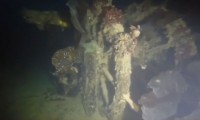Not basking in the success of its search for HMS Erebus, the flagship of Sir John Franklin during his last doomed voyage to find the Northwest Passage, Parks Canada continued its research on the Franklin expedition this season, studying the Erebus with sonar and seeking out any remains of the second ship, the HMS Terror. One of its partners in the endeavour is the Arctic Research Foundation whose vessel Martin Bergmann carries Parks Canada underwater archaeologists, side-scan sonar equipment and a remotely operated vehicle.
 On September 3rd, the crew of the Martin Bergmann found a large three-masted shipwreck at the bottom of, believe it or not, Terror Bay. The sonar data was confirmed by video from the ROV which allowed the team to compare the wreck to the plans of the HMS Terror. They found the ship’s bell, but couldn’t see the name of the vessel on it. One key feature that indicates this is the Terror is the exhaust pipe which is in the same location as the smokestack on the ship’s plans. It was added to HMS Terror to vent exhaust from the locomotive engine installed in the ship’s hull so it could cut through sea ice.
On September 3rd, the crew of the Martin Bergmann found a large three-masted shipwreck at the bottom of, believe it or not, Terror Bay. The sonar data was confirmed by video from the ROV which allowed the team to compare the wreck to the plans of the HMS Terror. They found the ship’s bell, but couldn’t see the name of the vessel on it. One key feature that indicates this is the Terror is the exhaust pipe which is in the same location as the smokestack on the ship’s plans. It was added to HMS Terror to vent exhaust from the locomotive engine installed in the ship’s hull so it could cut through sea ice.
The Terror was long believed to have been crushed by the hard, cold embrace of sea ice, but if this is the ship itself, it appears to be in excellent condition. Its three masts are broken, but it sits level on the sea floor about 80 feet below the surface, indicating that it sank gently. A long rope, still threaded through a hole in the deck, may have been used as an anchor line. The metal sheeting on the hull is intact. It seems the crew battened down the hatches, so to speak, as the ship was closed up tight. Of the four glass windows in the stern cabin, only one is broken. That bodes very well for the preservation of the contents.
On Sunday, a team from the charitable Arctic Research Foundation manoeuvred a small, remotely operated vehicle through an open hatch and into the ship to capture stunning images that give insight into life aboard the vessel close to 170 years ago.
“We have successfully entered the mess hall, worked our way into a few cabins and found the food storage room with plates and one can on the shelves,” Adrian Schimnowski, the foundation’s operations director, told the Guardian by email from the research vessel Martin Bergmann.
“We spotted two wine bottles, tables and empty shelving. Found a desk with open drawers with something in the back corner of the drawer.”
As with the discovery of Erebus, here too Inuit knowledge of the area played a pivotal role. The Martin Bergmann was headed to the north end of Victoria Strait to join the other ships on the Parks Canada mission when one of the crew members, Sammy Kogvik, told a story about how on a fishing trip six years ago he saw a large vertical piece of wood poking through the ice covering Terror Bay. He took some pictures of himself hugging the mast-like timber but lost the camera on the way home.
Taking the loss of the camera to be a bad omen — the Inuit have thought King William Island to be plagued with bad spirits since the death of everyone on the Franklin expedition — Kogvik told nobody of his find until he told Adrian Schimnowski on board the Martin Bergmann. Breaking from the lost history of explorers discounting Inuit evidence, the crew decided to take a detour from their destination and check out Terror Bay.
So it seems the Inuit are two for two on the Franklin expedition ships. Nice stats for people Lady Jane Franklin contemptuously dismissed as “savages” and their information, now proven to be accurate on pretty much every point, as “gossip” that should never have been repeated because it included reports of survival cannibalism among the crew.
The identification is not a sure thing yet. This ship was found a full 60 miles south of where the Terror was thought to have been destroyed based on the only known official records of the expedition ever found: an Admiralty form in a cairn at Victory Point on King William Island that noted the coordinates of where the two ships had been abandoned to the sea ice. But then again, Erebus was found much further south than expected too. Jim Balsillie, co-founder of the company that created the Blackberry and founder of the Arctic Research Foundation, has an idea of why this might be.
“Given the location of the find [in Terror Bay] and the state of the wreck, it’s almost certain that HMS Terror was operationally closed down by the remaining crew who then re-boarded HMS Erebus and sailed south where they met their ultimate tragic fate.”
Sounds reasonable. Parks Canada is circumspect about the find. They’re excited about it and recognize the significance of the find particularly in highlighting the inestimable value of the Inuit contribution, but they aren’t ready to call the Terror found until they’ve examined the details and confirmed it’s the real deal.
This CBC News story includes video of the shipwreck taken by the remotely operated vehicle.
[youtube=https://youtu.be/-_hug6UIyyE&w=430]